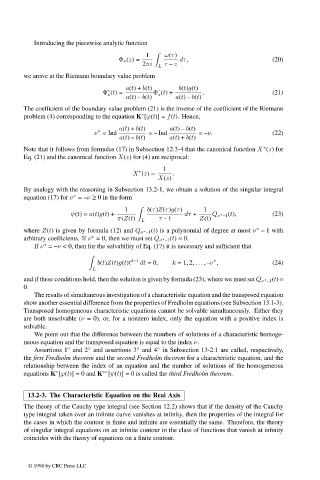Page 658 - Handbook Of Integral Equations
P. 658
Introducing the piecewise analytic function
1 ω(τ)
Φ ∗ (z)= dτ, (20)
2πi L τ – z
we arrive at the Riemann boundary value problem
a(t)+ b(t) – b(t)g(t)
+
Φ (t)= Φ (t)+ . (21)
∗ ∗
a(t) – b(t) a(t) – b(t)
The coefficient of the boundary value problem (21) is the inverse of the coefficient of the Riemann
problem (4) corresponding to the equation K [ϕ(t)] = f(t). Hence,
◦
a(t)+ b(t) a(t) – b(t)
∗
ν = Ind = – Ind = –ν. (22)
a(t) – b(t) a(t)+ b(t)
Note that it follows from formulas (17) in Subsection 12.3-4 that the canonical function X (z) for
∗
Eq. (21) and the canonical function X(z) for (4) are reciprocal:
1
X (z)= .
∗
X(z)
By analogy with the reasoning in Subsection 13.2-1, we obtain a solution of the singular integral
equation (17) for ν = –ν ≥ 0 in the form
∗
1 b(τ)Z(τ)g(τ) 1
ψ(t)= a(t)g(t)+ dτ + Q ν ∗ –1 (t), (23)
πiZ(t) τ – t Z(t)
L
∗
where Z(t) is given by formula (12) and Q ν ∗ –1 (t) is a polynomial of degree at most ν – 1 with
arbitrary coefficients. If ν = 0, then we must set Q ν ∗ –1 (t) ≡ 0.
∗
∗
If ν = –ν < 0, then for the solvability of Eq. (17) it is necessary and sufficient that
b(t)Z(t)g(t)t k–1 dt =0, k =1, 2, ... , –ν , (24)
∗
L
and if these conditions hold, then the solution is given by formula (23), where we must set Q ν ∗ –1 (t) ≡
0.
The results of simultaneous investigation of a characteristic equation and the transposed equation
show another essential difference from the properties of Fredholm equations (see Subsection 13.1-3).
Transposed homogeneous characteristic equations cannot be solvable simultaneously. Either they
are both unsolvable (ν = 0), or, for a nonzero index, only the equation with a positive index is
solvable.
We point out that the difference between the numbers of solutions of a characteristic homoge-
neous equation and the transposed equation is equal to the index ν.
◦
◦
◦
Assertions 1 and 2 and assertions 3 and 4 in Subsection 13-2.1 are called, respectively,
◦
the first Fredholm theorem and the second Fredholm theorem for a characteristic equation, and the
relationship between the index of an equation and the number of solutions of the homogeneous
equations K [ϕ(t)] = 0 and K [ψ(t)] = 0 is called the third Fredholm theorem.
◦∗
◦
13.2-3. The Characteristic Equation on the Real Axis
The theory of the Cauchy type integral (see Section 12.2) shows that if the density of the Cauchy
type integral taken over an infinite curve vanishes at infinity, then the properties of the integral for
the cases in which the contour is finite and infinite are essentially the same. Therefore, the theory
of singular integral equations on an infinite contour in the class of functions that vanish at infinity
coincides with the theory of equations on a finite contour.
© 1998 by CRC Press LLC
© 1998 by CRC Press LLC
Page 641

